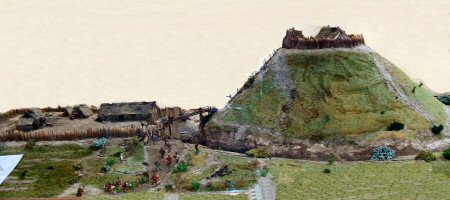In our last historical piece, we mentioned The Pale. A little further explanation is necessary.
The Norman sweep through east and north
in the thirteenth century resulted in effective political and military domination, largely unchallenged.
Norman Motte and Bailey
Eventually in 1315, aware of the defeats inflicted on the English in the larger island, some Irish leaders invited the brother of the Scottish king Robert the Bruce, to
Supplemented with a large force of Irish, he swept southwards clearing the country before him of English colonisers. The Earl of Ulster Richard de Burgo was defeated at Ballymena. The
He maintained his turbulent hold for most of the following three years. Then a decisive battle was fought at Faughart in 1318. The forces of Sir John de Birmingham defeated King Edward. He died in the battle and is buried in Faughart graveyard. The remnant of his forces fled, laying waste the country before them. They burned the Castle at Newry before embarking for
The Bruce visitation – short as it was – effected a great and long-lasting change in the relative holding in
For more than three centuries thereafter The Pale (the area of English rule of law) was very much circumscribed. Spence in his View of the State of Ireland says:
‘..before Bruce’s coming, The Pale extended as far as Dunluce [Castle on the Antrim coast] having in the middle Armagh and Carlingford, which are now the most out of bounds and not counted of The Pale at all which now stretches no further North than Dundalk.’
The English rebuilt the Castle at Newry burned by the Scots but Newry now formed a sort of out-garrison and the surrounding land was one time in the possession of the English and one time, the Irish. To complicate matters further a portion of the Abbey lands still lay within The Pale. The sea estuary was held by the Anglo-Normans, guarded on one side by the Fort at Greencastle and on the other by the walled town of
The Tudors changed everything and their agent in this area, Nicholas Bagenal – who acquired the status of
It is recorded that before his coming (in 1550) Newry comprised the Abbey building, recently confiscated by the English Crown, seventy-three houses, a water mill and a few orchards. By 1587 it is claimed there were three hundred dwellings.
.. Tory Hunter, John Johnson …
